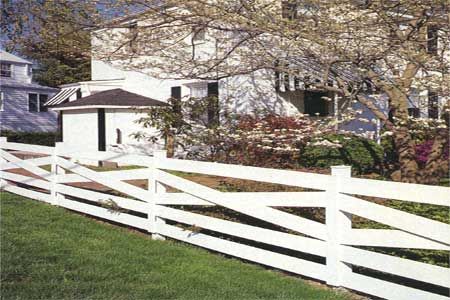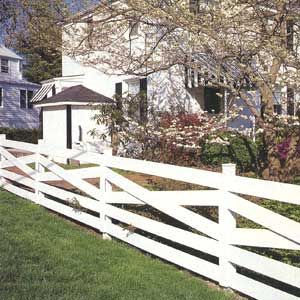
Homeowners who want more security and privacy should consider putting up new fences. The right fence can complement your home’s design style and give you the peace and quiet you’ve been seeking. Read our guide below for tips on how to pick the right fence material, how to easily install it as part of a do-it-yourself project, and how to add just the right finishing touches.
Understanding Different Fence Types
Before you start installing your fence, you need to decide which type is right for you. Look for a model that complements your home’s style and addresses your privacy needs. Read more about different available varieties below.
Classic Picket Fences
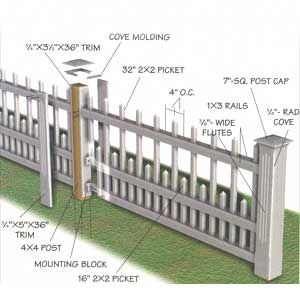
Picket fences are inspired by Federal-style architecture, and add a timeless charm to your property. This fencing type is available in classic white, but more contemporary designs feature pickets at different heights, which can create an especially alluring garden border.
Cross-Rail Fences
Cross-rail fences are perfect for rustic properties, and evoke the mood of rural landscapes. They don’t offer as much privacy as other types of fencing, but they successfully designate property lines, and can contain large animals. They’re also easy to build and customize.
Slat Fences
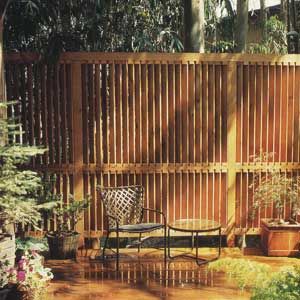
Slat fences are ideal for cities and suburbs where homes are close together. They’re typically between 6 and 8 feet tall, and offer lots of privacy without being too imposing.
Decorative Lattice Fences
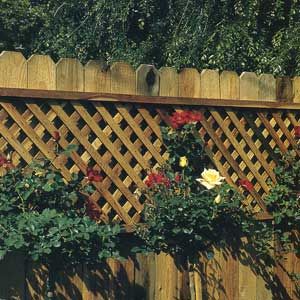
Lattice fencing features a solid lower section, and a top section that’s decorated with square or diamond crisscross patterns. This fencing type is a great choice for gardeners, and it’s as elegant as it is flexible. Many homeowners grow climbing plants and vines around lattice fencing, which enhances style and privacy.
Planning Your Fencing Project
Once you’ve chosen a type of fence to install, you can move forward with the planning stages. Read about measuring your property, securing the necessary permits, and more below.
Measuring Your Property
Use your lot survey to locate your property lines, or hire a professional surveyor to do it. Determine how much fencing you’ll need by measuring the perimeter of the space, and note any obstacles or terrain changes for which you’ll have to account. Account, too, for gates, and consider how they’ll influence the fencing’s overall layout.
Checking Local Regulations and Permits
Contact your local officials and ask about permit requirements, fence height restrictions, and setback rules. Some areas have strict rules about where fencing can go relative to lot lines and street frontages.
Your city may not require building permits for fencing, but you must still verify this. Violating a regulation you didn’t know about could lead to significant penalties.
Choosing the Right Fencing Materials
Fencing material ranges from beautiful, natural wood to durable, synthetic metal. Read more about different material types below.
Wood Fencing
Choose a wood fence that offers some natural resistance to rot and insects. Pine is the most affordable option, and hardwood is more expensive than other types. Redwood, cedar, and pressure-treated pine are all popular.
Wood fences require regular maintenance, including staining and painting every few years. These tasks protect wood fencing against weathering.
Metal and Vinyl Fencing
Consider metal or vinyl fencing if you don’t mind paying more upfront for less long-term maintenance. Aluminum is lightweight, rust-resistant, and ideal for sloped yards. Steel is incredibly durable, but may require occasional rust-prevention treatments. Vinyl comes in a variety of colors, and requires almost no maintenance.
Tools and Equipment You’ll Need
You’ll need a few of the specialized tools below to install your fencing efficiently.
- Carpenter’s level and plumb bob
- Circular saw and miter saw
- Drill and drill bits
- Hammer and nail set
- Measuring tape and marking stakes
- Post hole digger or power auger
- Safety gear (gloves, safety glasses, ear protection)
- Shovel and wheelbarrow
You can rent most of these tools from a hardware or home improvement store.
A Typical Fence Installation Project
Now you’re ready to install your fence. Follow the steps below.
Marking and Digging Post Holes
Mark your fence line with stakes and string, and use spray paint to mark the locations for your post holes in 6- to 8-foot increments. Once you’ve marked and double-checked everything, dig the post holes with a shovel or power auger.
Account for local frost lines when you’re digging your holes. A rule of thumb is to dig down to a third of the fence’s height, plus an additional 6 inches for gravel.
Setting Fence Posts
Place about 4 inches of gravel at the bottom of each hole for drainage. Set your posts in the holes, and use a level to make sure they’re plumb. Then tamp dirt around the holes.
If the end of the fence features posts that support a gate, or freestanding posts, you’ll need to pour a concrete footing. To do this, dig a hole, add 4 inches of gravel, set in the post, and fill the hole with concrete. Allow it to cure according to the manufacturer’s specifications.
Installing Rails and Pickets
Once you’ve set your posts, you can attach the horizontal rails. You’ll need at least two rails for most fencing: one for the top and one for the bottom. Secure them to the posts using galvanized nails or screws. Then install your pickets or fence boards so that they’re evenly spaced and level across the top. Secure these to the posts with galvanized nails or screws.
Adding Finishing Touches
Complete your fence by adding decorative elements such as post caps or finials. If you’re installing a gate, make sure it’s level and can swing freely.
If your fence is made of wood, apply a protective finish to protect the material against moisture and UV damage. Stain, varnish, and paint are all suitable options. If you use paint, you must apply a coat every five to seven years. Always prime the bare wood first for the best results.
